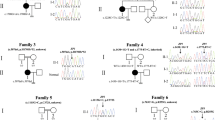Abstract
Purpose
Mutations in the zona pellucida glycoprotein genes have been reported to be associated with empty follicle syndrome (EFS) and abnormal zona pellucida (ZP). In this study, we performed genetic analysis in the patients with female infertility due to abnormal zona pellucida and empty follicle syndrome to identify the disease-causing gene mutations in these patients.
Methods
We characterized three patients from two independent families who had suffered from empty follicle syndrome or abnormal zona pellucida. Whole exome sequencing and Sanger sequencing were used to identify the mutations in the families. Western blot was used to check the expression of wild type and mutant disease genes.
Results
We identified two novel mutations in these patients, including a novel compound heterozygous mutation (c.507delC, p. His170fs; c.239 G>A, p. Cys80Tyr and c.241 T>C, p. Tyr81His) in ZP1 gene and a compound mutation in ZP2 gene (c.860_861delTG, p.Val287fs and c.1924 C>T, p.Arg642Ter). Expression of the mutant ZP1 protein (p. Cys80Tyr and p. Tyr81His) is significantly decreased compared with the wild-type ZP1. Other three mutations produce truncated proteins.
Conclusions
Our findings expand the mutational spectrum of ZP1 and ZP2 genes associated with EFS and abnormal oocytes and provide new support for the genetic diagnosis of female infertility.




Similar content being viewed by others
References
Hughes DC, Barratt CL. Identification of the true human orthologue of the mouse Zp1 gene: evidence for greater complexity in the mammalian zona pellucida? Biochim Biophys Acta. 1999;1447(2–3):303–6. https://doi.org/10.1016/s0167-4781(99)00181-5.
Chakravarty S, Kadunganattil S, Bansal P, Sharma RK, Gupta SK. Relevance of glycosylation of human zona pellucida glycoproteins for their binding to capacitated human spermatozoa and subsequent induction of acrosomal exocytosis. Mol Reprod Dev. 2008;75(1):75–88. https://doi.org/10.1002/mrd.20726.
Chiu PC, Wong BS, Lee CL, Pang RT, Lee KF, Sumitro SB, et al. Native human zona pellucida glycoproteins: purification and binding properties. Hum Reprod (Oxford, England). 2008;23(6):1385–93. https://doi.org/10.1093/humrep/den047.
Ganguly A, Bukovsky A, Sharma RK, Bansal P, Bhandari B, Gupta SK. In humans, zona pellucida glycoprotein-1 binds to spermatozoa and induces acrosomal exocytosis. Hum Reprod (Oxford, England). 2010;25(7):1643–56. https://doi.org/10.1093/humrep/deq105.
Greve JM, Wassarman PM. Mouse egg extracellular coat is a matrix of interconnected filaments possessing a structural repeat. J Mol Biol. 1985;181(2):253–64. https://doi.org/10.1016/0022-2836(85)90089-0.
Rankin T, Talbot P, Lee E, Dean J. Abnormal zonae pellucidae in mice lacking ZP1 result in early embryonic loss. Development (Cambridge, England). 1999;126(17):3847–55.
Rankin TL, O'Brien M, Lee E, Wigglesworth K, Eppig J, Dean J. Defective zonae pellucidae in Zp2-null mice disrupt folliculogenesis, fertility and development. Development (Cambridge, England). 2001;128(7):1119–26.
Coulam CB, Bustillo M, Schulman JD. Empty follicle syndrome. Fertil Steril. 1986;46(6):1153–5. https://doi.org/10.1016/s0015-0282(16)49898-5.
Kim JH, Jee BC. Empty follicle syndrome. Clin Exp Reprod Med. 2012;39(4):132–7. https://doi.org/10.5653/cerm.2012.39.4.132.
Yariz KO, Walsh T, Uzak A, Spiliopoulos M, Duman D, Onalan G, et al. Inherited mutation of the luteinizing hormone/choriogonadotropin receptor (LHCGR) in empty follicle syndrome. Fertil Steril. 2011;96(2):e125–30. https://doi.org/10.1016/j.fertnstert.2011.05.057.
Chen T, Bian Y, Liu X, Zhao S, Wu K, Yan L, et al. A recurrent missense mutation in ZP3 causes empty follicle syndrome and female infertility. Am J Hum Genet. 2017;101(3):459–65. https://doi.org/10.1016/j.ajhg.2017.08.001.
Sun L, Fang X, Chen Z, Zhang H, Zhang Z, Zhou P, et al. Compound heterozygous ZP1 mutations cause empty follicle syndrome in infertile sisters. Hum Mutat. 2019. https://doi.org/10.1002/humu.23864.
Yuan P, Li R, Li D, Zheng L, Ou S, Zhao H, et al. Novel mutation in the ZP1 gene and clinical implications. J Assist Reprod Genet. 2019;36(4):741–7. https://doi.org/10.1007/s10815-019-01404-1.
Zhou Z, Ni C, Wu L, Chen B, Xu Y, Zhang Z, et al. Novel mutations in ZP1, ZP2, and ZP3 cause female infertility due to abnormal zona pellucida formation. Hum Genet. 2019;138(4):327–37. https://doi.org/10.1007/s00439-019-01990-1.
Huang HL, Lv C, Zhao YC, Li W, He XM, Li P, et al. Mutant ZP1 in familial infertility. N Engl J Med. 2014;370(13):1220–6. https://doi.org/10.1056/NEJMoa1308851.
Dai C, Hu L, Gong F, Tan Y, Cai S, Zhang S, et al. ZP2 pathogenic variants cause in vitro fertilization failure and female infertility. Genet Med. 2019;21(2):431–40. https://doi.org/10.1038/s41436-018-0064-y.
Nishimura K, Dioguardi E. Molecular basis of egg coat cross-linking sheds light on ZP1-associated female infertility. Nat Commun. 2019;10(1):3086. https://doi.org/10.1038/s41467-019-10931-5.
Tsubamoto H, Hasegawa A, Nakata Y, Naito S, Yamasaki N, Koyama K. Expression of recombinant human zona pellucida protein 2 and its binding capacity to spermatozoa. Biol Reprod. 1999;61(6):1649–54. https://doi.org/10.1095/biolreprod61.6.1649.
Acknowledgments
We would like to thank Sang Qing and Lei Wang from Fudan University for providing the gift of ZP1 and ZP2 plasmids. We also thank all patients for their participation.
Funding
This work was supported by the National Natural Science Foundation of China (81000079, 81170165, and 81870959 to X.Z.) and supported by the Program for HUST Academic Frontier Youth Team.
Author information
Authors and Affiliations
Corresponding authors
Ethics declarations
Conflict of interest
The authors declare that they have no conflict of interest.
Additional information
Publisher’s note
Springer Nature remains neutral with regard to jurisdictional claims in published maps and institutional affiliations.
Electronic supplementary material
ESM 1
(PDF 509 kb)
Rights and permissions
About this article
Cite this article
Luo, G., Zhu, L., Liu, Z. et al. Novel mutations in ZP1 and ZP2 cause primary infertility due to empty follicle syndrome and abnormal zona pellucida. J Assist Reprod Genet 37, 2853–2860 (2020). https://doi.org/10.1007/s10815-020-01926-z
Received:
Accepted:
Published:
Issue Date:
DOI: https://doi.org/10.1007/s10815-020-01926-z




